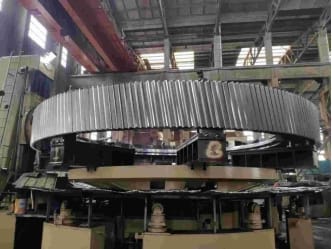In the world of manufacturing, during production inspection is a critical activity that takes place throughout the production process. It is a key element in ensuring the quality, efficiency, and overall integrity of the final product. In this post, we will delve into the significance, methods, and challenges of during production inspection in detail.
The Significance of During Production Inspection
- Quality Assurance: The primary purpose of during production inspection is to maintain and uphold high-quality standards. By closely monitoring the production process at various

Gear Run Out Machining Check During Production Inspection stages,any potential defects or deviations can be identified early on. This allows for timely corrective actions to be taken, preventing the production of substandard goods. A well-executed process helps to build a reputation for reliability and quality, which is crucial in today’s competitive market.
- Cost Control: Detecting issues during production rather than after the product is completed can save significant costs. It avoids the need for reworking entire batches of products or scrapping them, which can be very costly in terms of materials, labor, and time. By addressing problems as they arise, during production inspection helps to minimize waste and optimize resource utilization.
- Process Optimization: Through during production inspection, valuable insights can be gained into the production process itself. Any inefficiencies or areas for improvement can be identified and addressed, leading to enhanced productivity and better overall performance. This continuous improvement cycle is essential for staying competitive in the manufacturing industry.
- Compliance with Standards: Many products are subject to specific regulations and quality standards. During production inspection ensures that the product is being manufactured in accordance with these requirements, reducing the risk of non-compliance and potential legal issues.
- Customer Satisfaction: A product that meets or exceeds expectations is more likely to satisfy customers. By ensuring the quality of the product through during production inspection, manufacturers can enhance customer satisfaction and loyalty, which is vital for long-term business success.
Methods
- Visual Inspection: This is one of the most common methods of during production inspection. Trained inspectors visually examine the product for any obvious defects, such as cracks, blemishes, or misalignments. This method is relatively simple and quick but may have limitations in detecting more subtle issues.
- Measurement and Testing: Precise measurements and various tests are conducted to verify the dimensions, performance, and functionality of the product. This may include using tools such as calipers, micrometers, and testing equipment to ensure that the product meets the required specifications.
- Sampling Inspection: Instead of inspecting every single unit, a sample of the production is selected for inspection. This method is based on statistical principles and helps to reduce the inspection time and cost while still providing a reasonable level of confidence in the quality of the overall production.
- In-process Monitoring: This involves continuous monitoring of the production process itself, such as temperature, pressure, and speed. By keeping an eye on these parameters, potential issues can be detected early and addressed before they affect the final product.
Challenges
- Human Error: Despite the best efforts of inspectors, there is always a risk of human error. Fatigue, distraction, or lack of experience can lead to missed defects or incorrect assessments. To minimize this risk, it is important to have well-trained and experienced inspectors and to implement quality control systems.
- Complex Production Processes: In some cases, the production process may be very complex, with multiple interrelated components and operations. This can make it more difficult to conduct a thorough and accurate during production inspection, as it may be challenging to isolate and identify the source of potential issues.
- Time Constraints: Meeting tight production schedules can sometimes make it difficult to carry out detailed inspections at every stage. This may result in a compromise in the quality of the inspection or the need to prioritize certain aspects over others.
- Changing Product Specifications: In a dynamic manufacturing environment, product specifications may change frequently. This can make it challenging to keep up with the latest requirements and ensure that is adapted accordingly.
Best Practices – During Production Inspection
- Establish Clear Inspection Criteria: Clearly define the standards and criteria that need to be met during production inspection. This helps inspectors to make consistent and accurate assessments.
- Train Inspectors Regularly: Provide ongoing training and development opportunities for inspectors to keep them up-to-date with the latest inspection techniques and technologies.
- Use Advanced Inspection Technologies: Incorporate modern technologies such as machine vision, automated testing equipment, and data analytics to enhance the efficiency and accuracy of during production inspection.
- Foster Communication and Collaboration: Encourage open communication between the inspection team, production personnel, and other relevant stakeholders. This helps to ensure that any issues are addressed promptly and effectively.
- Document and Analyze Inspection Results: Keep detailed records of the inspection results, including any defects identified, corrective actions taken, and the status of the production process. Analyze this data to identify trends and areas for improvement.
Conclusion
During production inspection is a critical aspect of the manufacturing process that plays a vital role in ensuring product quality, optimizing production processes, and meeting customer expectations. By understanding the significance, methods, challenges, and best practices, manufacturers can take proactive measures to improve the quality and efficiency of their operations. Investing in a robust during production inspection process is an investment in the long-term success of the business and the satisfaction of its customers.
Learn more Successful Arctic module fabrication, steel structure, modular and skid, steelwork, supplier audit, DNV Class, Oil & Gas, welding supervisor, welding quality inspection, CWI CSWIP welding inspector, pump and pipe, stainless steel fabrication and CNAS ISO 17025 9712 NDT NDE practice via below-
https://www.jsc-safe.com/steel-structures-modules-machining/

